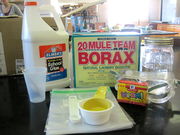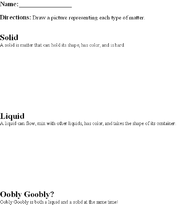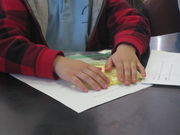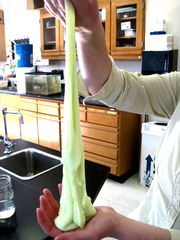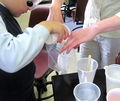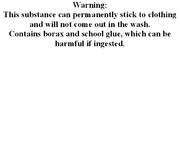Oobly Goobly
| Students @ Work - a student collaborative writing project. Help us by providing feedback on the Discussion page. |
| Instant wiki maker | Making handouts | Editing tips |
Contents
- 1 Student worthiness
- 2 Primary biological content area covered
- 3 Materials
- 4 Handouts
- 5 Description of activity
- 6 Lesson plan
- 7 Figure 11: Warning note to attach to bagsPotential pitfalls
- 8 Math connections
- 9 Literature connections
- 10 Connections to educational standards
- 11 Next steps
- 12 Reflections
- 13 Citations and links
- 14 Common mistakes
Biology In Elementary Schools is a Saint Michael's College student project from a course that ran between 2007 and 2010 and fully described in this book chapter. The student-created resources have been preserved here for posterity. Link under 'toolbox' for printer-friendly versions of the exercises. Click on handouts to print full resolution versions. Please see Wikieducator's disclaimer, our safety statement, and the Creative Commons licensing in English and in legalese.
Student worthiness
Tried and Trusted.
Primary biological content area covered
This activity explores the states of matter and shows students that some substances have properties of both solids and liquids. The properties of solids include color, ability to hold shape, breakability, hardness, etc. Properties of liquids include color, ability to flow and mix with other liquids, and taking the shape of the container. Solids and liquids are made up of certain molecule structures that give them their properties. Some substances, like oobly goobly, can be both solids and liquids, because of their molecule structure. These are called non-Newtonian fluids, and are made up of polymers. Students will be able to explore some of the properties of polymers and non-Newtonian fluids by making and experimenting with oobly goobly.
Materials
Handout
Safety Goggles
Box of Borax
Water
Measuring Cups
Measuring Spoons
Food Coloring, assorted colors
Quart-Sized Ziploc Freezer bags
1 Gallon Elmer's Glue
Jars or containers to mix the ingredients in
Plastic or paper cups to mix the glue and water in
Spoons or popsicle sticks for mixing
Permanent marker to write names on bags
Warning notes to attach to the bags
For each student:
1 Pair Safety Goggles
1/4 cup of glue
About 1/8 cup of water
1/2 teaspoon of borax mixed with 1/2 cup water
1 plastic cup
1 Ziploc freezer bag
1-2 food coloring colors
Spoon/Popsicle stick for mixing.
Pencil/Pen
Handouts
Here is a simple handout that can be used to introduce the activity. This will get students thinking about the different types of matter and what they are like before they create the oobly goobly.
Description of activity
In this activity students will make their own oobly goobly by mixing the ingredients together in a plastic bag. In the process, they will explore the properties of solids and liquids, and find out that some materials (like oobly goobly) can be both a solid and a liquid. Students will also learn about the simple molecule make-up of oobly goobly and how that allows the substance to be both a liquid and a solid at the same time. Students will be able to experiment with different colors and trade with each other to make striped or tie-dyed oobly goobly! They will take their oobly goobly home at the end of the activity.
- Steps to Making Oobly Goobly
Lesson plan
Before Lesson Begins: Before each group mix the 1/2 teaspoon of borax with the 1/2 cup of water in a mason jar or other sealable container. Mix one container for each student. Have the glue ready and pour water into cups for students to measure out. Have all other materials in place for the students.
Introduction:
- Distribute safety goggles to students and make sure they all wear them before beginning the activity.
- Begin by giving each student a handout and start discussing the properties of solids and liquids. Make sure you explain what matter is.
- Ask what a liquid is. Discuss properties of liquids and give example, such as the water used the activity.
- Ask what a solid is. Discuss properties of solids and give examples, such as the borax used in the activity.
- Show students the glue and discuss whether this is a solid or a liquid.
- Tell students that some things can be both a solid and a liquid at the same time, and explain that you'll be making one of those (oobly goobly) today. At this time you could show students an example of some pre-made oobly goobly and allow them to play with it, so they know how theirs should turn out. Also, if needed, make an example bag of oobly goobly front of the class to explain what needs to be measured and how things should be mixed.
Activity:
- Divide students up into groups of two (if necessary)
- Give each student his/her own bag, measuring cup and measuring spoon.
- Help each student then measure out the glue and water and mix them together in a paper/plastic cup with a Popsicle stick (Figures 5 and 6).
- When the glue mixture is well mixed, have students pour it into the bag (see Figure 6).
- Help each student pour the water/borax solution into his/her bag (See Figure 7).
- Allow students to put a few drops of 1-2 colors of food coloring into the bag
- Students should then close their bags tightly, pushing out the air, and agitate and squish the bags constantly until everything is well mixed (See Figures 8 and 9).
- Oobly goobly may need to sit for a few minutes or longer to get to the right consistency.
- When it looks and feels like oobly goobly has been made, allow students to re-open the bags and take out a small bit of their oobly goobly to play with.
- Encourage students to see whether the oobly goobly is a solid or a liquid by dropping it, pushing it, rolling it, or pouring it slowly from hand to hand (See Figure 4).
- If there is time and students wish, allow them to trade some of their oobly goobly with each other to see what results they can get.
Conclusion:
Make sure all students clean up after themselves and return or throw away all materials used. Allow them to take home their bags of oobly goobly but make sure they are completely sealed and not leaking or wet.
Useful tip Regardless of the consistency achieved during class time, we found that the final product improved overnight.
Potential pitfalls
It's important to measure the ingredients very precisely when making oobly goobly so that the substance is of a good consistency. If the measurements are off, then the final product may become too much of a solid or too much of a liquid which will create a mess when the students take the oobly goobly out of the bag! Try the recipe out a few times to perfect it before you do it with students, and have some pre-made oobly goobly on hand if the students' doesn't work. It is also important to keep extra bags on hand just in case some of them break while the students are mixing the ingredients together. Some students may not want to get their hands dirty while making the oobly goobly or may think that touching the final product is gross, but just remind them that they can always wash their hands at any point during the activity. Oobly goobly may not become the right consistency in the twenty minutes of time allotted. In this case, allow students to use pre-made oobly goobly for the final part of the activity, and assure them that if they let their bags sit for a while the oobly goobly will become the right consistency (they made need to pour off some excess liquid). Also, oobly goobly can stick to and stain clothing and won't come out in the wash, and it 'contains materials that may be harmful if ingested. Make sure you warn students about this ahead of time and send a note home to parents with the oobly goobly (See Figure 11).
Math connections
This experiment will allow students to measure out the ingredients of Oobly Goobly, which will help them exercise their math skills.
Literature connections
Bartholomew and the Oobleck by Dr. Seuss. This is an amusing fictional story about what happens to a kingdom when a substance like our oobly goobly (but much stickier) falls from the sky.
For time's sake, we will not be able to read this book during our experiment, but we will introduce it to students and show a few pictures to them. Also, we will suggest that they read it at home with their families.
Another activity to go along with this experiment would be to make up a story about Oobly Goobly, starting with the statement, "This is Oobly Goobly, but it's not really Oobly Goobly, it's..." (And then children could make a certain shape out of it and pretend it is something different; for example, it could be a robin's egg or a shoelace). Students could pass the Oobly Goobly around and each child could make it into something different. After a few sentences are constructed about the Oobly Goobly's imaginary identity, pictures could be drawn to go along with the writing. This would not only make a literature connection, but an art connection as well.
Connections to educational standards
Properties of Matter
S1-2:12
Students demonstrate their understanding of the States of Matter by…
• Identifying, describing and comparing the state of matter of solids and liquids.
Science Concepts:
a. Solids and liquids are states of matter and have properties that can be described.
b. Solids have the properties of hardness, color, and ability to maintain shape.
c. Liquids have properties of color, tendency to flow, ability to mix with other liquids, taking up the shape of the container.
Next steps
The students may be interested in learning more in depth about exactly why oobly goobly is both a liquid and a solid and in that case the teacher could teach the students more about molecules and the make-ups of the different substances involved in making the oobly goobly. The teacher could also read the book Bartholemew and the Oobleck by Dr. Seuss and afterwards have the students create their own story about their oobly goobly. With older grades more controlled experiments could be done to see how the oobly goobly responds in a series of different situations, such as dropping, throwing, pouring, pushing, heating, cooling, etc.
Reflections
This experiment went extremely smoothly. We set up different stations that we had the students go through; each station was a step in the oobly goobly-making process. We had children line up with their bags, and one teacher put their names on the bags with a permanent marker. After this they moved on to the next teacher, who helped them measure out the glue into a plastic cup. They moved from there to the next teacher, who measured out an 1/8 cup of water and helped them pour it into the cup of glue and stir until it was well-mixed together. Before moving on to the next station, the teacher helped the students pour the glue-water mixture into their bags. At the last station, the teacher (who had moved there after she was done labeling the bags) helped students pour the pre-mixed borax and the food coloring into their bags, and oversaw them get started with mixing everything together inside the bags. Having these different stations really helped things stay under control and gave us and the students a definite form of structure. We were able to do the whole activity within the time limits which was a good feeling. The only aspect that was somewhat rushed was the discussion of solids, liquids, and the oobly goobly, which is both. The students were first graders so going in depth about states of matter would have been difficult, but we could have maybe spent a little more time on the differences between solids and liquids and what characteristics of both oobly goobly possessed. Had there been more time at the end we would have explored the properties of oobly goobly more in depth by allowing children to experiment with it. We had to send children on soon after they got all the ingredients mixed together, so they weren't able to see a final product while they were with us, and, since we sent the bags home with the students, we weren't able to see how the oobly goobly turned out. However, all the bags were very colorful and looked well on their way to making oobly goobly. More importantly, the students had lots of fun and were very enthusiastic and engaged in the whole process. Overall, this was a great activity that all of the students seemed to enjoy with only some minor hiccups!
Citations and links
Dr. Seuss, Bartholomew and the Oobleck. Random House. New York, New York: 1976.
We developed our own recipe for oobly goobly, but adapted it from the following sources:
http://www.kinderteacher.com/oobleck.htm
http://homeschooling.gomilpitas.com/extras/Gak.htm (look at the Flubber and Glorax recipes).
http://wikieducator.org/Oobleck
Common mistakes
This section is strictly for editorial suggestions and will not be part of your final product. The most common editorial suggestions I make are listed here.
| Work in progress, expect frequent changes. Help and feedback is welcome. See discussion page. |

